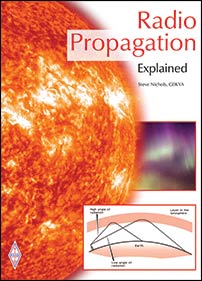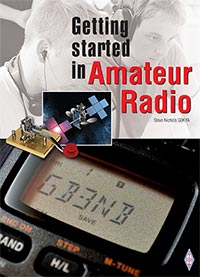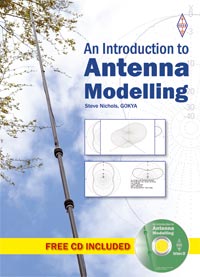 |
| The 80-10m EFHW |
This design came from attempts to find an 80m antenna that could fit into a small space. This was because Norfolk Amateur Radio Club likes to take part in the 80m Club Championship (we won in 2016), but many members don't have enough space for a full size (132ft) dipole or the 100-102 feet needed for a G5RV or W5GI antenna.
This antenna lets you get on to 80m in a horizontal distance of about 12m (40ft) when used as an inverted sloper with the apex at 8m, although you'll be down a couple of S points on a dipole. But if the other station is 59+20dB, you'll be about 59 +5 or 10db, so all is not lost!
This antenna lets you get on to 80m in a horizontal distance of about 12m (40ft) when used as an inverted sloper with the apex at 8m, although you'll be down a couple of S points on a dipole. But if the other station is 59+20dB, you'll be about 59 +5 or 10db, so all is not lost!
I take little credit for this as it was outlined in PD7MAA's and IK0IXI's blogs after extensive work on the antenna in the Netherlands. However, there was little on their blogs in terms of its performance or SWR characteristics. Hence this write-up.
Download the 80-10m EFHW antenna guide
Update 29/1/17:
I've updated the guide to look at replacing the coil with a 7MHz trap and also putting the antenna up as an inverted V. The trap and about 14.2m of insulated wire would improve the 80m performance a little, if you have the space, but possibly at the cost of the 14MHz performance. Surprisingly the MMANA-GAL model suggests the inverted V would be worse for 80m NVIS communication.
Update 09/02/17
I thought I would bite the bullet and took the wire and loading coil off and replaced it with about 130ft of insulated wire. This needs some final tuning, but gives a low SWR across 80 and 40m, and SWRs below 3:1 across the higher bands. The last 20-25 feet had to run along a wooden fence. Performance on 80m was equal to or down 1-2 S pts on the W5GI. Performance on 40m was down quite a bit, perhaps 2-3 S pts.
It appeared to be directional compared with the W5GI (which was at right angles). Equal performance on 20m to Tunisia.
So the performance on 80m was marginally better than the shortened version, but the 40m performance was worse. This was confirmed with WPSR tests. The performance on 20m was roughly similar. The bands higher than 20m were mostly closed during the test.
I think the compromise position of the 132ft wire didn't help the antenna's performance and I think that overall, the 66ft and loading coil version was better on 40m an higher.. If you could get the whole wire in the clear you might better results.
Update 29/1/17:
I've updated the guide to look at replacing the coil with a 7MHz trap and also putting the antenna up as an inverted V. The trap and about 14.2m of insulated wire would improve the 80m performance a little, if you have the space, but possibly at the cost of the 14MHz performance. Surprisingly the MMANA-GAL model suggests the inverted V would be worse for 80m NVIS communication.
Update 09/02/17
I thought I would bite the bullet and took the wire and loading coil off and replaced it with about 130ft of insulated wire. This needs some final tuning, but gives a low SWR across 80 and 40m, and SWRs below 3:1 across the higher bands. The last 20-25 feet had to run along a wooden fence. Performance on 80m was equal to or down 1-2 S pts on the W5GI. Performance on 40m was down quite a bit, perhaps 2-3 S pts.
It appeared to be directional compared with the W5GI (which was at right angles). Equal performance on 20m to Tunisia.
So the performance on 80m was marginally better than the shortened version, but the 40m performance was worse. This was confirmed with WPSR tests. The performance on 20m was roughly similar. The bands higher than 20m were mostly closed during the test.
I think the compromise position of the 132ft wire didn't help the antenna's performance and I think that overall, the 66ft and loading coil version was better on 40m an higher.. If you could get the whole wire in the clear you might better results.













Hi, Would this work ok if it could be fitted into a loft?
ReplyDeleteTake a look at this antenna disinformation about the 80m end fed half wave.
ReplyDeletehttps://www.youtube.com/watch?v=QGPxp5LX3Q8
That's a lot of wire to fit into a loft without bending it back and forth rather severely. You should have a counterpoise/ground connection at the "ground" on the step-up transformer to prevent the coax braid from being a radiator of the signal. Having all this close to your transmitter is asking for RF in the shack, and I would expect you will have trouble operating any digital mode requiring a PC hooked to your transmitter. There are better antenna compromises out there than an EFHW, and keep in mind, it's only a half wave on one band. The impedance will vary wildly from band to band, so the step up transformer won't be a perfect match. It may be good enough for the transmitter's built-in tuner. You may need an external tuner to tune on bands where the SWR is >3:1. Join the ham-antennas group on groups.io and search through past messages as this has been discussed many times and there was a recent discussion (Oct 2022) on this. The conclusion was that you can do better with other antennas, often in less space. Donald KX8K
ReplyDeleteThis was never intended to be a loft antenna. And I used a choke on the feedline which stopped any RF. I don't think this is a brilliant performer on 80m, but at least it gets people on the air. 40m, 20m and 10m performance was OK.
ReplyDelete